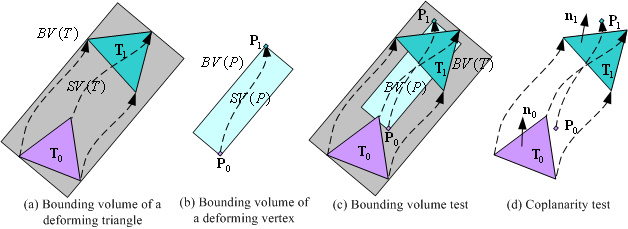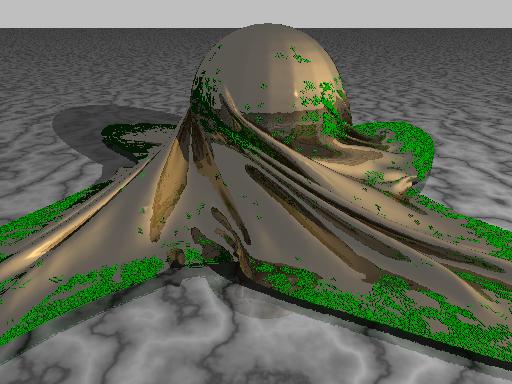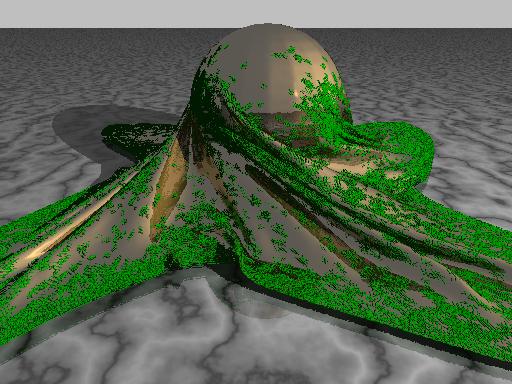
University of North Carolina at Chapel Hill, USA

Deforming Filter: For a deforming triangle T and a
deforming vertex P defined by T0,T1
and P0,
P1
respectively, the bounding volume test (c) becomes quite conservative. The
coplanarity test (d) checks whether a penetration between the primitives during
the time interval. If the vertex is always on the same side of the triangle
during the entire time interval, then the four vertices associated with that
elementary test cannot be coplanar during the time interval [0, 1] and
therefore, no collision occurs.


Edges involved by EE tests with different
culling methods: This figure shows edges (highlighted in green) used by
EE tests during a specific frame of the Cloth benchmark with coplanarity-based
culling and bounding volume based culling respectively. Comparing to only
bounding volume based culling, the number of EE elementary tests are reduced by
80% with the deforming non-penetration filter (left).
Benchmark Lion: In this simulation, a stone falls on top of a Chinese lion model
and the lion gradually breaks into a high number of colliding pieces. This model
has 805K vertices and 1.6M triangles. In this fracture scene with changing
topologies, our new algorithm based on a deforming filter increases the culling
efficiency and reduces the number of elementary test by 10x as compared to
prior methods and improves the performance of the CCD algorithm by 4.1x.
Abstract We present a
novel culling algorithm that uses deforming non-penetration filters to improve
the performance of continuous collision detection (CCD) algorithms. The
underlying idea is to use a simple and effective filter that reduces the number
of false positives and the elementary tests between the primitives. This filter
is derived from the coplanarity condition and can be easily combined with other
methods used to accelerate CCD. We have implemented the algorithm and tested its
performance on many non-rigid simulations. In practice, we can reduce the number
of false positives significantly and improve the performance of overall CCD
algorithm by 1.5-8.2 times.
Paper (PDF 1.7 MB)
Min Tang, Dinesh Manocha, Ruofeng Tong, Fast Continuous Collision Detection using Deforming Non-Penetration Filters, in Proceedings of ACM SIGGRAPH
Symposium on Interactive 3D Graphics and Games (i3D 2010), Washington DC, Feb. 19-21, 2010: 7-13. @inproceedings{1730806,
Video (15 MB) UNC dynamic model benchmark
repository
MCCD:
Multi-Core Collision Detection between Deformable Models using Front-Based
Decomposition Fast Collision
Detection for Deformable Models using Representative-Triangles
DeformCD: Collision Detection
between Deforming Objects
Self-CCD: Continuous Collision Detection for Deforming Objects
Interactive Collision Detection
between Deformable Models using Chromatic Decomposition
Fast Proximity Computation Among
Deformable Models using Discrete Voronoi Diagrams
CULLIDE: Interactive Collision
Detection between Complex Models using Graphics Hardware
RCULLIDE: Fast and Reliable
Collision Culling using Graphics Processors
Quick-CULLIDE: Efficient Inter-
and Intra-Object Collision Culling using Graphics Hardware
We would like to thank Jieyi Zhao, Jiang Lin, Peng Du and Ming Lin for useful
discussions and the benchmarks. The cloth models were provided by Rasmus Tamstorf at Disney Animation.
This research is supported in part by National Basic Research Program of China
(No. 2006CB303106), MOE-Intel special research fund on information technology
(No. MOE-INTEL-09-05), ARO Contract W911NF-04-1-0088, NSF awards 0636208,
0917040 and 0904990, DARPA/RDECOM Contract WR91CRB-08-C-0137, and Intel. Tang is
supported in part by Natural Science Foundation of China (No. 60803054),
National Key Technology R&D Program, China (No. 2006BAF01A45-05), Natural
Science Foundation of Zhejiang, China (No. Y107403), Doctoral subject special
scientific research fund of Education Ministry of China (No. 20070335074). CB #3175, Department of Computer Science 
Contents
author = {Tang, Min and Manocha, Dinesh and Tong, Ruofeng},
title = {Fast continuous collision detection using deforming non-penetration filters},
booktitle = {I3D '10: Proceedings of the 2010 ACM SIGGRAPH symposium on Interactive 3D Graphics and Games},
year = {2010},
isbn = {978-1-60558-939-8},
pages = {7--13},
location = {Washington, D.C.},
doi = {http://doi.acm.org/10.1145/1730804.1730806},
publisher = {ACM},
address = {New York, NY, USA},
}
Related Links
Acknowledgements
University of North Carolina
Chapel Hill, NC 27599-3175
919.962.1749
geom@cs.unc.edu